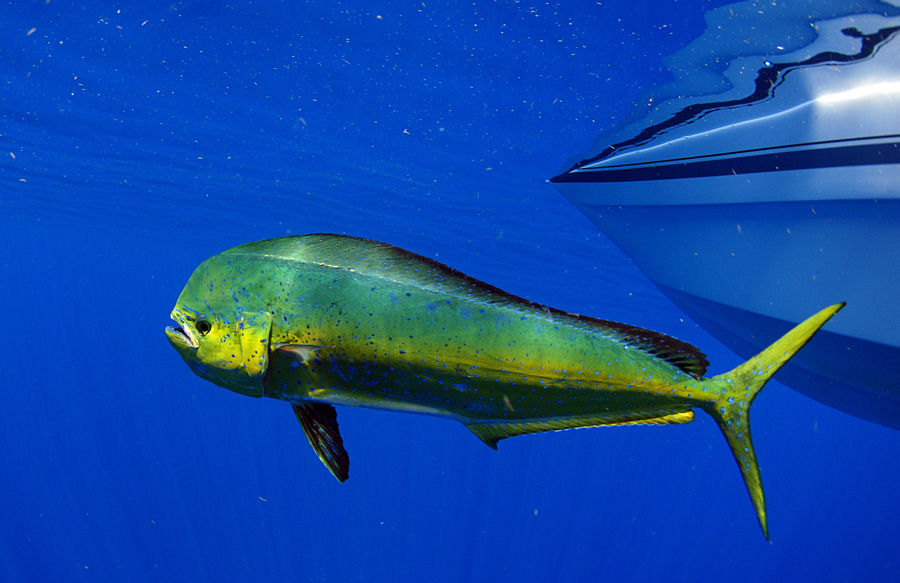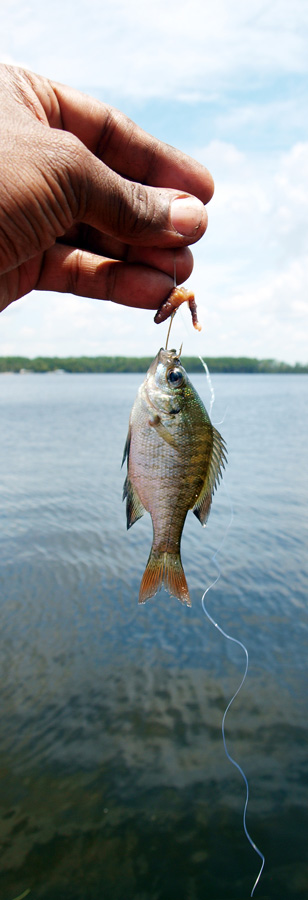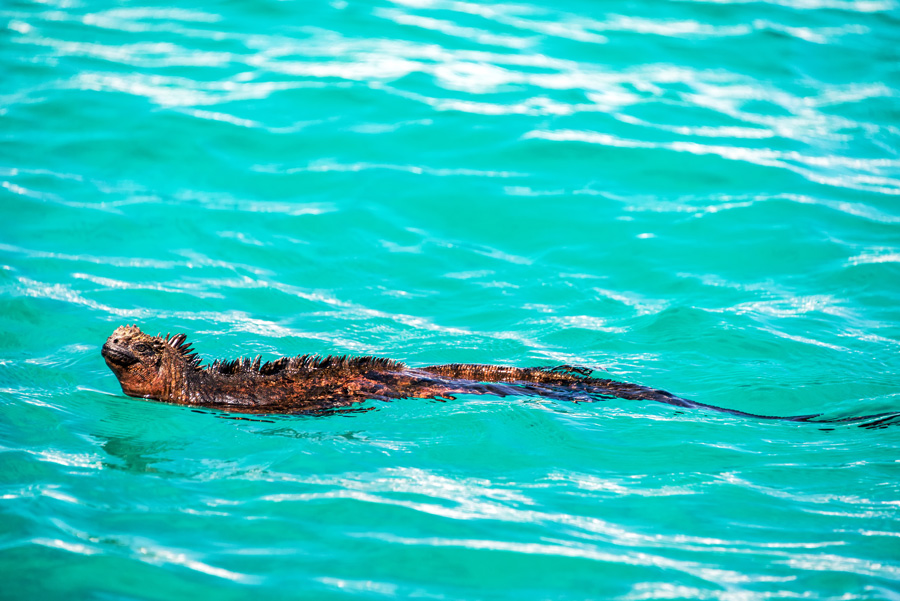“Time is a beast, devouring all, insatiable. . . .”
That pretty much sums up a captain’s life, but I wouldn’t trade my guiding experiences for anything. You never know what’s going to happen on any given day out on the water; each day truly is unique. Below are a few entertaining nuggets from my decades on the water. Enjoy.
 If it can go wrong. . . .
If it can go wrong. . . .
I had a client who expressed a desire to catch a dolphin (aka mahi-mahi and dorado), preferably a large one, on a fly. Normally, when a client makes such a request, I counsel him as to what time of year would offer the best chance for success. But since this request was made on the morning of the trip, during a time of year when finding a large dolphin was somewhat doubtful, I resigned myself to trying my best to pull off this unlikely feat. After a quick glance at his equipment, my client’s 10-weight rod and reel combo looked up to the task. In retrospect, a closer exam would have been wise, and you’ll see why.
Chum bait was nonexistent that day, so besides throwing hookless teasers on a spinning rod, my only option was to cruise around searching for floating weeds and try to find fish hiding under them. We made our way out several miles offshore and started the search for the debris and weeds that often hold fish. There was very little in the way of such material, but we continued our search.
Finally, we saw a beautiful log, several meters long, covered in barnacles and surrounded by weeds—the very picture of perfect dolphin habitat. Quietly approaching and scanning the area for movement, I saw nothing. My heart sank, because if this beautiful piece of real estate wasn’t holding fish, it was unlikely anything else would be.
I readied the client, explaining that he needed to be prepared to cast at a moment’s notice as I started working the area around the log with a teaser plug. Teaser plugs are great in place of chum bait. The fish immediately comes in hot and ready to eat, and it can generate some spectacular strikes. But alas, no fish appeared after a couple casts. I took a few steps over to the console to look at the depth finder, hoping it would tell me that there were fish holding down deep. My client asked if he could take a few casts. Not expecting it to do any good, I told him to have at it and continued to scan the depth finder.
That’s when several things happened in quick succession. The client dropped a cast about 50 feet out and immediately exclaimed, “Holy crap!” Out of the corner of my eye, I saw a large shape streak out from directly under the boat, heading straight for the fly. Faster than it can be told, what I estimated to be at least a 50-pound dolphin crushed the fly at about 25 mph, felt the hook, and hit the afterburners, leaving straight away at what seemed like 50 mph.
As the client was desperately trying to clear the slack, a perfect half-hitch was formed around the reel, with no chance of untangling it. When the full weight and speed of the dolphin came to bear, the reel broke off from the reel foot, and still tangled, came up against the first stripping guide. In a split second, that stripping guide was ripped off the rod, and the reel came up against the second stripping guide with the same result. Now, the reel came up against the first snake guide on the top section of the two-piece rod and the forces at play pulled the two sections apart. The whole mess—reel, tangle, and ripped-off stripping guides, went sailing into the ocean. For several seconds, in utter silence, the compilation of gear was plainly visible as the dolphin towed it out of sight, jumping enthusiastically as it went.
The client, standing there holding just the butt section of his ruined rod, turned to me and said,
“That was GREAT!”
Given that I had never experienced any kind of equipment malfunction close to this, I had to investigate the cause. Upon closer examination, the screws that had been holding the reel body to the reel foot were so corroded that I could turn them to powder between my fingers. And judging from the rusted stumps where the stripping guides once were, this rod may have never been rinsed off after saltwater exposure. The client confirmed this, saying he thought rinsing was a waste of time. He also confirmed that he had been using a straight piece of 50-pound leader material, because he “didn’t want to chance losing any fish.”
 You never know what you’ll see out there.
You never know what you’ll see out there.
One winter I took two clients out for spinner sharks. These clients were experienced saltwater anglers but had never fished for spinners. After setting off, I gave them the rundown on what to expect. Among other things, I described the free-jumping that the spinners do on a regular, and at times constant, basis. In the 60- to 100-pound range, they explode out of the water, spinning lengthwise. Sometimes they spin so fast that it’s hard to focus on them. It’s a pretty large animal and pretty spectacular to watch.
Arriving at the area where I knew there to be sharks, I got busy down on the deck preparing the chum needed to bring the sharks within casting range. As I had my head down, both of these
gentlemen abruptly exclaimed, “Good god! Did you see that?! What the hell was that?”
“What did it look like?” I asked, without raising my head.
“Something huge just came flying out of the water right there!”
“Well, that’s a spinner shark,” I replied, slightly chuckling. “That’s what we are here to fish for.” I turned my head in the direction they were pointing just in time to see a gray whale approximately 40 feet in length reenact the Pacific Life commercial with a full-body vertical launch; it breached not 100 feet off the side of the boat. The spray from its splash almost reached us; it was that close.
“Okay, that is not a spinner shark, and we’re not fishing for it.”
Gray whales are not common in my area at all. I may see only one each year, so this was a real treat. The massive creature put on quite a show for us for over an hour, breaching regularly and performing a maneuver I still can’t really explain the purpose of. In 30 feet of water, this thing would go vertical, stick its nose in the sand, get its tail about 10 feet in the air, and go back and
forth, slapping the water with concussive sounds. It would stay in this position for a full five minutes before moving on. I believe it was calling out to its brethren off in the distance, but we didn’t see other whales that day. Eventually, we let the whale go on its way, and we returned to the sharks. But the rest of the day we all had grins on our faces from the experience.
 You are always at the mercy of the sea.
You are always at the mercy of the sea.
One summer day, the weather was fairly typical—hot, calm, and humid, with small pop-up showers in the area. These small storms were easily visible and moving very slowly. It wasn’t a problem getting out of their way, and there was almost no lightning accompanying them. The problem was that these storms hid a monster that was fast approaching from the southwest.
This was before smart phones, and I had no radar on board. My first clue that something was amiss should have been the disappearance of all the large sportfishing boats. Suddenly, there was not another boat in sight, and off to the west was a black wall of rain with an almost constant rumbling of thunder emitting from it. We were only a couple of miles from the beach and and short run back to the safety of the harbor, but it was too late. The initial blast of wind preceding the rain dropped the air temperature by 20 degrees. If you ever experience this sort of instantaneous temperature change, just know that it’s the weather gods coming for you.
To the west, the whitecaps and sea foam generated by the wind looked like a carpet of snow that was marching toward us. As the storm came off the beach 2 miles away, the black wall of rain completely obliterated the coastline, and the lightning went into overdrive, with multiple bolts visible simultaneously. The rain and the wind hit us almost at the same moment, with a force that made capsizing a real possibility even with a 26-foot boat weighing several tons.
We had secured everything loose and donned our raingear, and I quickly had the engines started and the bow pointed into the wind. Under any normal situation like this, standard operating procedure is bow into the waves and hold position until the storm passes, because it’s really pointless to do anything else. But as the wind approached and passed the 70 mph mark, SOP went out the window.
Even being just 2 miles from the beach (a very short distance for waves to build to any size), the sea went from almost flat to a constant battalion of breaking monsters bearing down on us. The 12-foot hillsides were so close together that being head-to quickly became dangerous, with waves breaking into and filling the boat, compounding the capsizing possibility. My only option was to spin around and ride it down wind, which was quite a maneuver given I had only a matter of seconds to turn before the next wave was on me.
I managed to get it done, but it was dicey at best. Keep in mind that the rain was coming down so hard that the other end of the boat was barely visible, and bolts of lightning were coming down on both sides simultaneously. And these were the kind of bolts where the flash and the sound hit you at the same moment.
By this time, exactly eight minutes had passed since first becoming aware of the impending doom—not much time to do a lot about it.
We stayed in this position for a while. I’m not sure how long, because every second required steering adjustments to keep from going broadside to the maelstrom, and going broadside would have been instant disaster. Even going with the waves, large amounts of water were crashing over the stern into the cockpit. You know by listening to the thunder how long this will go on. When you hear that the majority of the thunder has passed, the worst is over. Forty-five minutes into this storm I could still hear thunder approaching off to the west. It felt like a lifetime.
In the middle of all this, my phone rang. A captain friend who I had seen earlier in the day was on the other end. “You’re not still out there, are you?” he asked.
“Yes,” I said, “and I’m a bit busy. What do you want?”
“You need to get out of there,” he said. “There’s a tornado in that cell!” I explained to him the situation with the waves, lightning, rain, and inability to maneuver, and that I couldn’t really give a crap about the tornado and hung up. I resisted asking him to tell my wife that I loved her, because that wouldn’t really help any of us. Especially my wife—or my client.
We rode out the storm and made it safely back to port, but it was an experience I would prefer not to experience again, although it is worth noting two things: First, I was never so glad to be operating a catamaran, which handled it all in stride, and second, my client, who was great at keeping mostly calm, offered the opinion that after 16 years in the US Navy, it was the worst storm he had ever been in.
You can go light, but be careful.
 When I first started guiding bluewater fly fishing in the early 1990s, I thought there wasn’t much
When I first started guiding bluewater fly fishing in the early 1990s, I thought there wasn’t much
realistic use for fly rods smaller than 8-weights. In pretty short order, I changed that thinking completely. Now I typically carry rods as small as a 4-weights, and I am in the process of building a 3-weight.
While there are days when the big fish I’d like to show clients are absent, it’s rare indeed that smaller fish aren’t available. Small members of the jack family and small tunas and mackerel are great fun on light tackle and have saved many a day for me. Dolphin up to 10 pounds will make a 4- or 5-weight dance and make you forget all about trout.
One day while out on a fun trip with friends, I came across a nice-sized log with lots of life around it. Triggerfish, small jacks called rudderfish, and bait were just a cloud around this thing. I had a livewell stuffed with small chum baits, and I started scattering them around the log, looking to fire up any predators in the area. Quickly, surface strikes and explosions began, signaling the arrival of small blackfin and skipjack tuna. Scanning the breaking fish, most all looked to be on the small side, only a couple of pounds apiece. Try as I might, I could not see anything larger, so I grabbed a 4-weight and a 5-weight and gave them to my buddies Quintin and Chris.
Standing on the gunwale to get better visibility while continuing to scatter chum, I tried to be the early warning if a larger fish, inappropriate for the rods they were using, showed up. I pretty much failed miserably in the attempt, because there was suddenly a flash of brilliant purple, and Chris found himself with a fish blistering line off the 5-weight reel. The first run took enough line off the reel that the bare spool was visible beneath the backing. And though every subsequent run was shorter, they weren’t shorter by much.
Over the course of almost 30 minutes, the fish made eight runs well into the 150-yard-plus zone, and it never gave up until Chris finally battled it back to the boat to be netted. It turned out to be a skipjack tuna approaching 12 pounds. The fight was epic and a joy to watch.
 It’s not all about the fish.
It’s not all about the fish.
One day, several miles offshore with clients, I was searching a weed line for dolphin. This particular weed line was very uniform—nice fresh Sargasso weed, bright yellow, stretching off into the distance, with very little of anything else mixed in with it. While scanning weed lines like this, I look both in the water next to the boat (because if you’re moving slowly and quietly enough, dolphin will swim right up to the boat), and I look ahead along the weed line in the distance (because surface activity is a very good way of locating not only dolphin, but many other desirable species as well).
While scanning out in front, I spotted something that stood out like a sore thumb. It was brick red, with wide black vertical stripes. And then it started moving. Out of this patch of weeds materialized an iguana about 5 feet long—just floating along like it was the most normal thing in the world.
After a quick discussion with my passengers, we decided he really would prefer to be on dry land and not in the middle of the ocean with nothing to eat. So I grabbed my large landing net and scooped him up, depositing him in the front of the boat. It became obvious that Iggy (well, of course we named him) had been out there a long time.
It probably washed out to sea during a storm in the tropics somewhere. A healthy iguana this size would normally weigh upwards of 50 pounds. I doubt Iggy weighed 25. The tip of his tail had been bitten off, his eyes were mostly swelled shut from salt water, and he wasn’t moving particularly fast at all.
He spent the rest of the day with us fishing, but he laid claim to the front of the cockpit, using his tail quite effectively like a bullwhip anytime someone came too close. I had two impressive welts on my leg by the time we came back in the inlet. I stopped to clean the dolphin we had caught, spraying Iggy down with freshwater while I did. This made him perk up quite a bit, and for the ride back to the boat ramp, he took up a position on the tip of the bow. This brought quite a few incredulous stares from other boaters and a line of people fishing off of a bridge we passed under.
I tied up at the dock, and after a few minutes, Iggy slowly made his way onto the dock and moved away into some nearby underbrush. He most definitely had a look of “thank you” in his eyes as he made his way into the brush.



